 Your portfolio website sucks.
You built it to showcase your cumbersome genius, the work on there is spectacular, and it should be the envy of the entire web community.
It was designed to bring in new clients, get you picked up on design blogs, win the respect of your peers, prove to your ex-boss that you do have what it takes afterall, and impress your Mum.
And yet it still sucks. Today we're going to tell you why, covering the three most common mistakes in portfolio websites.
Your portfolio website sucks.
You built it to showcase your cumbersome genius, the work on there is spectacular, and it should be the envy of the entire web community.
It was designed to bring in new clients, get you picked up on design blogs, win the respect of your peers, prove to your ex-boss that you do have what it takes afterall, and impress your Mum.
And yet it still sucks. Today we're going to tell you why, covering the three most common mistakes in portfolio websites.
Reason 1: no one, bar none, likes small thumbnail images
You will never pique anyone's curiosity with a tiny thumbnail. If you are using them, your options are:- Cram everything into a very small space so the full meaning is lost
- Crop to an interesting part of the image so the full meaning is lost
Reason 2: no one cares about your client's name
If you're not making the thumbnail image mistake there is a good chance you are making the other big portfolio mistake: the stack of names. You have created a minimal website where the type is the art. Jan Tschichold would be proud of you. But unless you are working for globally recognized brands likes Adidas, Radiohead and the UN, it's unlikely the list of clients you have means anything to anyone. They may even have local recognition where you are, but the web is a global community and if users see a list including Torque Hole, Sminky's and RadPad, it will mean nothing to them. And yet potential clients are coming to your website to see what a great designer you are. They want to see work that resonates with them. After a few clicks on names that sound hollow and made up, they will get tired and bored. You are taking away the user's choice to view what they would like to view. As with the thumbnails problem, users will get clicking fatigue if they have to click on a whole raft of meaningless names. You should let the work speak for itself. In a previous design life I made the same mistake with my portfolio — the result? A drop-off rate that would make you wince. Visitors would spend seconds on the site and very quickly get bored of the clicking — or be appalled by the work — and leave. Mercifully, for the good of the internet, that site no longer exists.Reason 3: half the world can't view Flash anymore
It's time to move on.What you can do about it
Have your portfolio images writ large from the first moment users land on your site. Make them available and knowable at first glance. If people want to find out more about a project then they can choose to, and you can give them a tour of that job. If you have to have thumbnails, have large thumbnails or have a rollover option to make the work pop so that your visitors can then make their informed choice. Here are some examples of incredibly talented people who have made good use of web space to make their projects sing for their visitors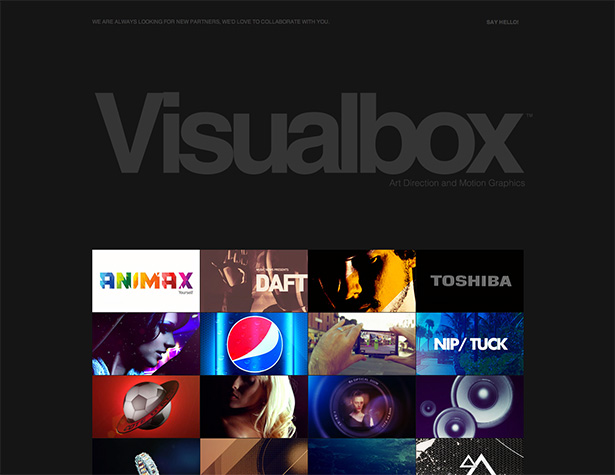 Buenos Aires-based motion graphics studio Visual Box is a superb example to kick off with. They have a large and sumptuous thumbnail set from which you can choose to view more, or you can just simply scroll down and get a good overall view of their entire portfolio. That way you can get a fantastic overview of their work without going to the monumental effort of a single mouse click.
Buenos Aires-based motion graphics studio Visual Box is a superb example to kick off with. They have a large and sumptuous thumbnail set from which you can choose to view more, or you can just simply scroll down and get a good overall view of their entire portfolio. That way you can get a fantastic overview of their work without going to the monumental effort of a single mouse click.
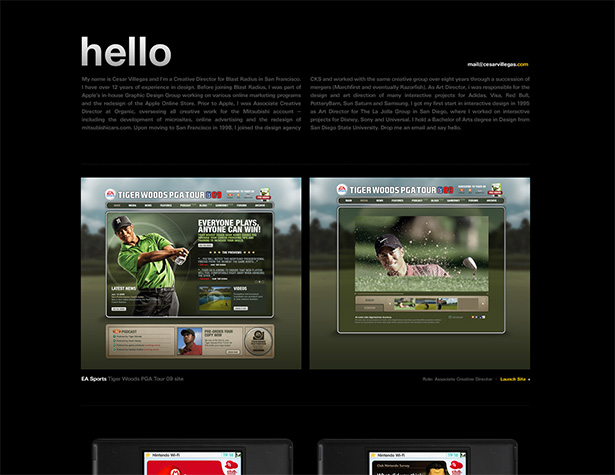 Similarly, Cesar Villegas has all his work on the first page with images set large, and you can scroll down to view projects or click on them to view more.
Another great example is Teacake Design,
Similarly, Cesar Villegas has all his work on the first page with images set large, and you can scroll down to view projects or click on them to view more.
Another great example is Teacake Design,
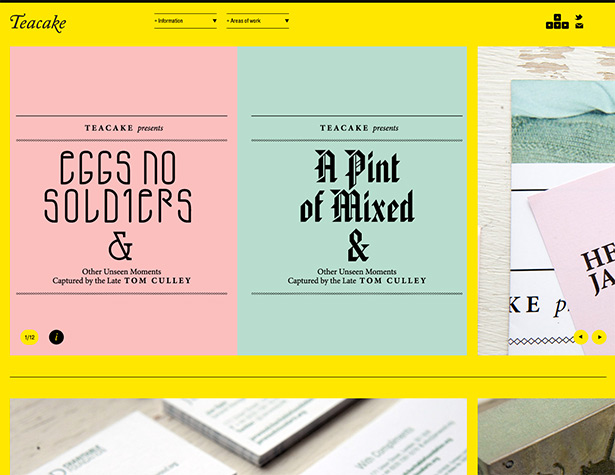 bold and beautiful, it's a joy to spend time on this site.
bold and beautiful, it's a joy to spend time on this site.
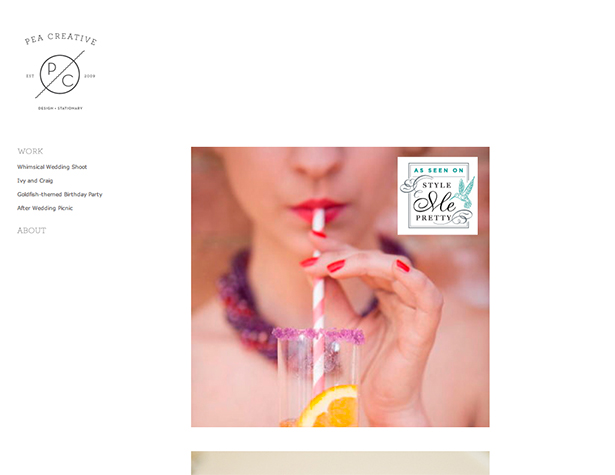 Pea Creative's site does employ the minimal Stack of Names, but the landing page drops you right into the work — and each beautiful and well sized image represents another project, giving the user a chance to organize their visit by the sound or the look of what they like.
But then we don't all want to have portfolios that just have large images and that scroll down now do we? We don't want clients to look at sites differentiated only by typeface choice. Here are some sites that make good use of the large thumbnail.
Pea Creative's site does employ the minimal Stack of Names, but the landing page drops you right into the work — and each beautiful and well sized image represents another project, giving the user a chance to organize their visit by the sound or the look of what they like.
But then we don't all want to have portfolios that just have large images and that scroll down now do we? We don't want clients to look at sites differentiated only by typeface choice. Here are some sites that make good use of the large thumbnail.
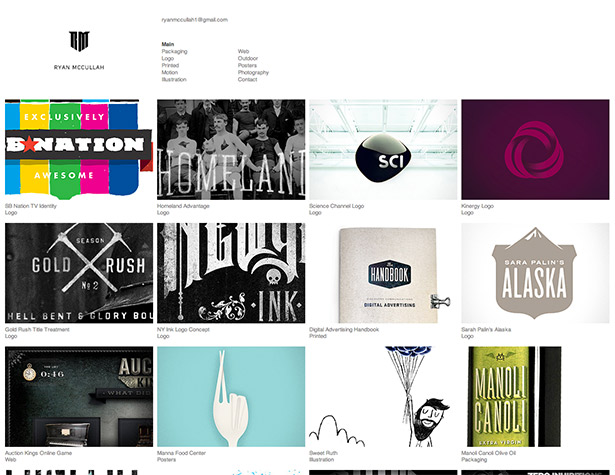 Large enough to get a good look at the work, small enough to get 15 images above the fold when viewed on an average screen. Ryan McCullah has an amazing portfolio of work too, the kind of design work that makes you ache that you didn't think of it first.
Large enough to get a good look at the work, small enough to get 15 images above the fold when viewed on an average screen. Ryan McCullah has an amazing portfolio of work too, the kind of design work that makes you ache that you didn't think of it first.
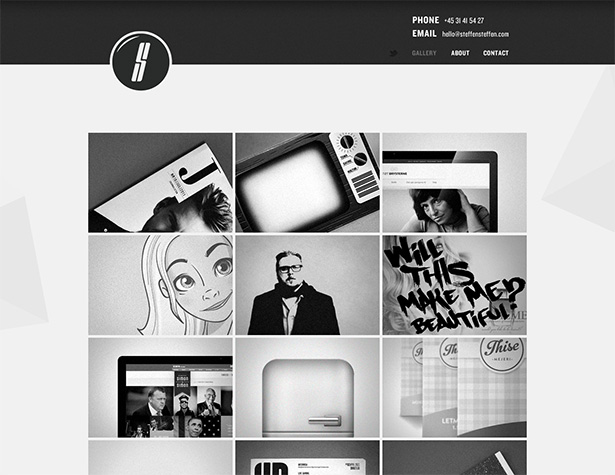 Steffen Christiansen uses a clean, simple two-color site to exude a quiet confidence.
Steffen Christiansen uses a clean, simple two-color site to exude a quiet confidence.
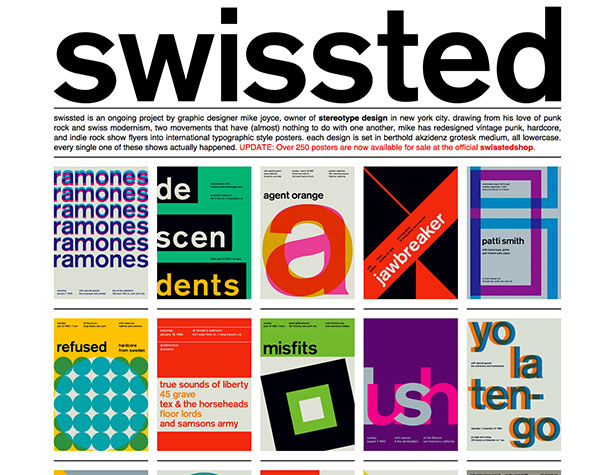 A design resource in itself, the swissted site is the perfect example of a tasty large thumbnail.
So I hope in this article I have shown you what you can do to ensure you make the best use of your work. You need to give people what you already know they want: to get the information they need as quickly as possible. Why make them wait to find out? You are a great designer. Let them feast on your talent.
A design resource in itself, the swissted site is the perfect example of a tasty large thumbnail.
So I hope in this article I have shown you what you can do to ensure you make the best use of your work. You need to give people what you already know they want: to get the information they need as quickly as possible. Why make them wait to find out? You are a great designer. Let them feast on your talent.
Mike Kammerling
Mike Kammerling is Creative Director of London-based graphic design studio Tinder + Sparks. You can read his blog here, and follow him on Twitter here.
Read Next
3 Essential Design Trends, May 2024
Integrated navigation elements, interactive typography, and digital overprints are three website design trends making…
How to Write World-Beating Web Content
Writing for the web is different from all other formats. We typically do not read to any real depth on the web; we…
By Louise North
20 Best New Websites, April 2024
Welcome to our sites of the month for April. With some websites, the details make all the difference, while in others,…
Exciting New Tools for Designers, April 2024
Welcome to our April tools collection. There are no practical jokes here, just practical gadgets, services, and apps to…
How Web Designers Can Stay Relevant in the Age of AI
The digital landscape is evolving rapidly. With the advent of AI, every sector is witnessing a revolution, including…
By Louise North
14 Top UX Tools for Designers in 2024
User Experience (UX) is one of the most important fields of design, so it should come as no surprise that there are a…
By Simon Sterne
What Negative Effects Does a Bad Website Design Have On My Business?
Consumer expectations for a responsive, immersive, and visually appealing website experience have never been higher. In…
10+ Best Resources & Tools for Web Designers (2024 update)
Is searching for the best web design tools to suit your needs akin to having a recurring bad dream? Does each…
By WDD Staff
3 Essential Design Trends, April 2024
Ready to jump into some amazing new design ideas for Spring? Our roundup has everything from UX to color trends…
How to Plan Your First Successful Website
Planning a new website can be exciting and — if you’re anything like me — a little daunting. Whether you’re an…
By Simon Sterne
15 Best New Fonts, March 2024
Welcome to March’s edition of our roundup of the best new fonts for designers. This month’s compilation includes…
By Ben Moss
LimeWire Developer APIs Herald a New Era of AI Integration
Generative AI is a fascinating technology. Far from the design killer some people feared, it is an empowering and…
By WDD Staff

















